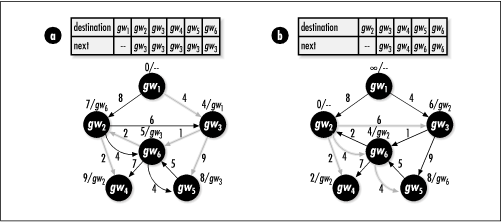Shortest Paths Example: Routing Tables
One application in which shortest paths play an important role is routing data between networks in an internet. Routing is the process of making informed decisions about how to move data from one point to another. In an internet, this is accomplished by propagating small sections of the data, or packets , along interconnected points called gateways. As each packet passes through a gateway, a router looks at where the packet eventually needs to go and decides to which gateway it should be sent next. The goal of each router is to propagate a packet closer and closer to its final destination.
In order to propagate a packet closer to its destination, each router maintains information about the structure, or topology , of the internet. It stores this information in a routing table. A routing table contains one entry for each gateway the router knows how to reach. Each entry specifies the next gateway to which packets destined for another gateway should be sent.
So that packets are continually sent along the best route possible, routers periodically update their routing tables to reflect changes in the internet. In one type of routing, called shortest path first routing, or SPF routing, every router maintains its own map of the internet so that it can update its routing table by computing shortest paths between itself and other destinations. Its map is a directed, weighted graph whose vertices are gateways and whose edges are connections between the gateways. Each edge is weighted by the performance most recently observed for a connection. From time to time, routers exchange information about topology and performance using a protocol designed especially for this purpose.
Example 16.4 is a function,
route, that computes the information necessary to update one
entry in a routing table using SPF routing. The function accepts the
list of path information returned in the
paths argument of
shortest. It uses this information to determine to which gateway a
router should send a packet next to reach its destination most
effectively.
To complete an entire table for a specific gateway, we first
call shortest with the gateway passed as
start. Next, for each destination to be
included in the routing table, we call route with
the destination passed as destination. We
pass the same function for match as was
provided to graph_init for the graph from which
paths was generated. The
route function follows parent pointers in
paths from the destination back to the
gateway and returns the best choice for moving a packet closer to its
destination in next. The vertex returned in
next points to the actual vertex in
paths, so the storage in
paths must remain valid as long as
next is being accessed.
Figure 16.5a illustrates the computation of a routing table for a router at gw1 in the internet shown (modeled using a graph similar to the one in Figure 16.3). Figure 16.5b illustrates the computation of the routing table for a router at gw2 . Notice how the shortest paths are different depending on where we start in the internet. Also, notice that in Figure 16.5b there is no way to reach gw1, so there is no entry for it in the table.
The runtime complexity of route is
O (n 2), where
n is the number of gateways in
paths. This is because we look up in
paths the parent of each vertex between the
destination we are interested in and the starting point in the
internet. If the shortest path between us and the destination contains
every gateway in paths, in the worst case
we may have to search the list of gateways n
times to find every parent.
/***************************************************************************** * * * -------------------------------- route.c ------------------------------- * * * *****************************************************************************/ #include <stdlib.h> #include "graphalg.h" #include "list.h" #include "route.h" /***************************************************************************** * * * --------------------------------- route -------------------------------- * * * *****************************************************************************/ int route(List *paths, PathVertex *destination, PathVertex **next, int (*match)(const void *key1, const void *key2)) { PathVertex *temp, *parent; ListElmt *element; int found; /***************************************************************************** * * * Locate the destination in the list of gateways. * * * *****************************************************************************/ found = 0; for (element = list_head(paths); element != NULL; element = list_next(element)) { if (match(list_data(element), destination)) { temp = list_data(element); parent = ((PathVertex *)list_data(element))->parent; found = 1; break; } } /***************************************************************************** * * * Return if the destination is not reachable. * * * *****************************************************************************/ if (!found) return -1; /***************************************************************************** * * * Compute the next gateway in the shortest path to the destination. * * * *****************************************************************************/ while (parent != NULL) { temp = list_data(element); found = 0; for (element = list_head(paths); element != NULL; element = list_next(element)) { if (match(list_data(element), parent)) { parent = ((PathVertex *)list_data(element))->parent; found = 1; break; } } /************************************************************************** * * * Return if the destination is not reachable. * * * **************************************************************************/ if (!found) return -1; } *next = temp; return 0; }

